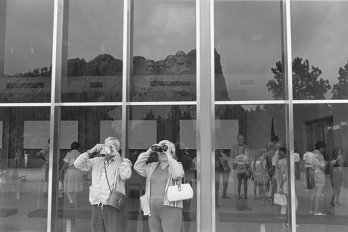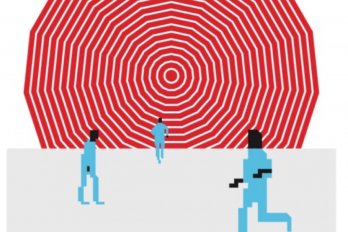rattenberg — When Franz Wurzenrainer, the mayor of Austria’s smallest city, surveyed all 480 of his citizens on what they most disliked about the place, more than half said that it was too dark in winter.
A cluster of medieval buildings and three church spires, Rattenberg lies on the south side of the River Inn, in the Austrian Alps. Behind it rise a craggy slope and a crumbling castle. While the hill has made a scenic backdrop for countless paintings and photographs, it casts a large shadow. From the end of November to the end of January, not a single ray of sun reaches the town’s casement windows, narrow alleys, and frigid fountains.
Wurzenrainer is determined that Rattenberg, which clings to the city status conferred upon it in 1393, stop its postwar population decline. Convinced that the city’s survival depends on satisfying citizens and trapping tourists, the pink-cheeked little man took Rattenberg’s predicament forty kilometres upriver to the Bartenbach LichtLabor.
From a state-of-the-art complex on an Alpine meadow above Innsbruck, the light laboratory’s forty architects, engineers, and cognitive psychologists have illuminated hundreds of sites, including the main mosques of Medina and Mecca, Zurich International Airport, the central train station in Lucerne, and the chancellor’s office in Vienna. But they have yet to bend the sun over a hill and into the darkest crannies of a medieval city.
The challenge was initially put to the fifteen students at Bartenbach’s affiliated lighting academy, who, after playing with various ideas, came up with a concept. By mounting a twenty-five metre-square heliostat — a mirror programmed to follow the course of the sun — on the north side of the river, they figured they could redirect sunlight across the valley to reflectors plastered on Rattenberg’s castle hill. These would in turn cast light down into Südtiroler Strasse, the more significant of the city’s two main streets.
The students’ cardboard model, which looks like an ambitious sciencefair project, caught the attention of international media. At the onset of 2005’s sunless season, journalists and television crews from around the world began pouring into the Gasthof Schlosskeller, Rattenberg’s only hotel. The regulars at the Schlosskeller pub can tell as many stories about that media storm as there are sets of chamois and mouton antlers mounted on the hotel’s walls. There was the photographer who waited an entire day in vain for a cloud to plunge Rattenberg into darkness, the Japanese tourists found whacking their way through the bush in search of mirrors, the television crew that used a fog machine to create a suitably doomed atmosphere. The story presented to the world ran more or less like this: Depressed citizens of Austrian village to be rescued by sci-fi light project.
Village. Depression. Two words Rattenbergers don’t want to hear.
“If I’m depressed,” says Sylvia Mölgg, whose husband owns the Schlosskeller, “it has nothing to do with the sun.” Frau Mölgg wears a polka-dotted purple apron, red sandals over socks, and a gold cross on a chain around her neck. She’s in the Schlosskeller kitchen, leaning against a deep-freeze that contains the non-mountable remains of her husband’s hunts. “People have been coming through Rattenberg since Attila the Hun. But today’s tourists just windowshop. They don’t stay long enough to buy a coffee. If they think that putting up mirrors is going to change that, they should go right ahead. God knows what all the European Union wastes its money on.”
The EU has indeed taken kindly to the Rattenberg project and subsidized much of the research and development. But the 30-percent cap on EU contributions to construction costs, estimated at 2 million euros, leaves a handsome sum for Austria’s smallest city to pay.
“Rattenberg has always been rich,” says Wurzenrainer, seated in his office in the town’s restored Augustinian cloister. He launches into a well-rehearsed monologue on medieval Rattenberg, which was a customs station on the border between Bavaria and Tyrol, a strategic point in trans-Alpine warfare, a hub for glass-blowing and copper and silver mining, and, at one time, home to more than a thousand burghers. “But nobody can expect me to come up with that sum.”
For a time, vague hopes hovered about the mayor’s office that the Bartenbach lab might invest massively in the Rattenberg project, which could serve as a prototype for dozens of similar sites in the immediate area. Bartenbach’s ceo, Helmar Zangerl, dashed such hopes. “We don’t get involved in financing or marketing,” he explains. “What we can deliver is a feasible concept.” Zangerl leads the way through the lab to a bunker-like room in which a large wired dome hangs over what looks like a Ping-Pong table.
“There are about ten skies in the world,” he says, fumbling with a few switches before summoning a technician to turn the thing on, “but I think this is probably the best.” The dome blinks to life, and there on the table is Rattenberg, one forty-third of its actual size. The beam of a headlight at the opposite end of the room hits reflectors above the shrunken city, and shafts of light fall across a few of its facades. “This is the only way to get a sense of the plasticity,” says Zangerl, crouching down, his nose at street level. He points to the shadows created by the gabled windows. “Here, for instance, is one unnatural aspect that we won’t be able to get around: the shadows will remain fixed in this position.”
Many Rattenbergers are having trouble getting around a few other aspects of the project. Although they haven’t seen this latest model, they seem to know enough about the plan to be convinced that it won’t work. Heinrich Unterrader is the self-appointed keeper of Rattenberg’s castle ruins. The eighty one-year-old and his wheelbarrow can be found there in pretty much any weather, remortaring the walls, digging for bones, and giving wayward youth ample reason not to vandalize the place. Heini, as he’s known locally, collected the signatures of eighty Rattenbergers opposed to the Bartenbach project and sent the petition to the state government, the conservation office responsible for Tyrol, and the media. In his two-page memorandum, written in calligraphy, Heini lambastes the “nonsense that has been disseminated by the media” and the “cockamamie nature of the entire plan,” which he claims would “completely disfigure” his beloved castle.
“I have nothing against the modern world,” says Heini, sitting in what was once a defensive tower in Rattenberg’s fortress and is today his home. “Bartenbach should carry on lighting underwater hotels in Abu Dhabi. But they have nothing to offer Rattenberg.”
Next door in the cloister, Mayor Wurzenrainer is making lists of potential private sponsors and authorities that need to be won over. A preservation committee’s judgment on the mirrors planned for the castle ruins looms large. Asked what his next step will be, he considers for a second, then replies, “A media strategy.”
He disappears into a back room and returns with a bottle of home-brewed plum schnapps, filling two elegant crystal glasses and raising his. “Hand-blown in Rattenberg. Cheers.”






